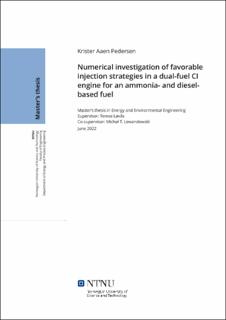| dc.description.abstract | Etter hvert som bevisstheten rundt menneskeskapte klimaendringer har vokst, har søken etter rene teknologier blitt et hett tema. Gjennom avtaler som Parisavtalen har mange land forpliktet seg til å redusere sine klimagassutslipp (GHG). Transportsektoren sto for rundt 27% av klimagassutslippene i 2019, noe som viser et betydelig potensial for forbedring. For å strebe etter en mindre forurensende transportsektor, ble det i denne oppgaven undersøkt injeksjonsstrategier og produsert veiledninger for kompresjonstenningsmotorer som går på to drivstoff. De to drivstoffene brukt i denne oppgaven, med fem forskjellige blandingsforhold, var n-heptan og det grønne alternative drivstoffet ammoniakk. Undersøkelsen ga figurer avhengig av ekvivalensforhold og temperatur der høye konsentrasjoner av NOx, sot og N2O ble fremhevet. Til slutt ble det utført en undersøkelse med en stokastisk reaktormodell for å finne gunstige injeksjonstidspunkt. Resultatene viste en betydelig drivstoffavhengighet når det gjelder sot og N2O-utslipp, mens området med høy NOx-konsentrasjon forble lite påvirket av endring av drivstoffsammensetningen. Den lave drivstoffavhengigheten for de høye NOx-konsentrasjonene ble sporet til bidraget til den termiske NOx-mekanismen. Lavere nivåer av NOx viste til en viss grad en drivstoffavhengighet, hvor drivstoff-NOx, prompt NOx og termiske De-NOx-mekanismer bidro i varierende grad til NOx når drivstoffsammensetningen ble endret. Sotdannelsespotensialet var lite bekymringsfullt i tilfeller med mer enn 50% av energien i drivstoffet fra ammoniakk. For disse sammensetningene ble andre utslipp som ammoniakk-slip og N2O av større betydning. N2O-utslippene viste lavt formasjonspotensial for fullt forbrente forhold, og gir enkeltsifrede eller lave tosifrede ppm-nivåer. Høye N2O-nivåer ble oppnådd i antennelsesfasen, definert som området mellom ingen forbrenning og stabiliserte utløpsforbrenningsforhold. I denne regionen ble det oppnådd høye nivåer som skapte en øy-lignende form lokalisert ved lavere temperaturer. Denne regionen ble mer betydningsfull med økende ammoniakkkonsentrasjon i drivstoffet, med høyere toppnivåer. Resultaten underbygger viktigheten av å hensynta N2O-utslipp når ammoniakk introduseres i forbrenningsapplikasjoner. SRM-simuleringene støttet også disse funnene. På grunn av noen usikkerhetsmomenter angående modellen, ble resultatene av dual fuel-drift ansett som feilaktige og trenger ytterligere undersøkelser. | |
| dc.description.abstract | As the awareness of human-induced climate changes has grown, the quest for clean technologies has become a hot topic. Through agreements such as the Paris Agreement, countries have obligated themselves to reduce their greenhouse gas (GHG) emissions. The transport sector accounted for around 27 % of the GHG emissions in 2019, revealing a substantial potential for reduction. To pursue a less polluting transport sector, it was in this thesis investigated injection strategies and produced guidelines for dual fueled compression ignition engines. The two fuels used, with five different blending rations, was n-heptane and the novel fuel ammonia. The investigation provided maps depending on equivalence ratios and temperature where high concentrations of NOx, soot, and N2O were highlighted. Lastly, to locate favorable injection timings, an investigation utilizing a stochastic reactor model was carried out. The results revealed a significant fuel dependency regarding soot and N2O emissions, while the high NOx concentration region remained little affected by changing the fuel composition. The low fuel dependency for the high NOx concentrations was traced to the thermal NOx mechanism's contribution. Lower levels of NOx exhibited a fuel dependency to some extent, as the fuel NOx, prompt NOx, and thermal De-NOx mechanisms contributed differently to changing fuel compositions. The soot formation potential was of little concern for cases with more than 50 % of the energy in the fuel provided from ammonia. For these compositions, other emissions such as ammonia slip and N2O became of greater importance. The N2O emissions exhibit low formation potential for fully combusted conditions, yielding single digits or low double digits ppm levels. High N2O levels were obtained in the ignition phase, defined as the region between no combustion and stabilized outlet combustion conditions. In this region, high levels were obtained creating an island shape located at lower temperatures. This region became more significant with increasing ammonia concentration in the fuel, with higher peak levels. This underpins the importance of N2O consideration when ammonia is introduced into combustion applications. The SRM simulations backed up these findings. However, due to some uncertainties regarding the model, dual fuel operation results were considered preliminary and needs further investigation. | |
